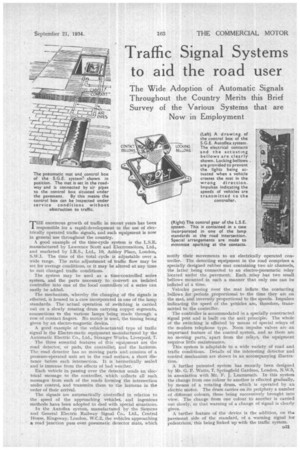Traffic Signal Systems
Page 89

If you've noticed an error in this article please click here to report it so we can fix it.
to aid the road user,
The Wide Adoption of Automatic Signals Throughout the Country Merits this Brief Survey of the Various Systems that are Now in Employment
T"E enormous growth of traffic in recent years has been responsible for a rapid) development in the use of electrically operated traffic signals, and such equipment is now in general use throughout the country.
A good example of the time-cycle system is the L.S.E. manufactured by Lawrence Scott and Electron'&tors, Ltd., and marketed by I.R.S., Ltd., 10, Ashley Place, London, SAV.1. The time of the total cycle is adjustable over a wide range. The ratio adjustment of traffic flow may be set for average conditions, or it may be altered at any time to suit changed traffic conditions.
The system may be used as a time-controlled series system, and the parts necessary to convert an isolated controller into one of the local controllers of a series can easily be added.
The mechanism, whereby the changing of the signals is .effected, is housed in a case incorporated in one of the lamp standards. The actual operation of switching is carried out on a slowly rotating drum carrying copper segments, connections to the various lamps being made through a row of contact fingers, No motor is used, the timing being given by an electro-magnetic device.
A good example of the vehicle-actuated type of traffic signal is the Electro-matic equipment manufactured by the Automatic Electric Co., Ltd., Stranger Works, Liverpool, 7.
The three essential features of this equipment are the road detector, or pads, the controller, and the lanterns, The road detector has no moving parts and consists of a pressure-operated unit set in the road surface, a short distance before each intersection. It is hermetically sealed and is immune from the effects of had weather.
Each vehicle in passing over the detector sends an electrical message to the controller, which collects all such messages from each of the roads forming the intersection under control, and transmits them to the lanterns in the order of their arrival.
The signals are automatically controlled in relation to the speed of the approaching vehicles, and ingenious methods have been adopted to deal with special situations.
In the Aittoilex system, manufactured by the Siemens and Gene'ral Electric Railway Signal Co., Ltd., Central House, Kingsway, London, W.C.2, the vehicles approaching a road junction pass over pneumatic detector mats, which notify their movements to an electrically operated controller. The detecting equipment in the road comprises a specially designed rubber mat containing two air channels, the latter being connected to an electro-pneumatic relay located under the pavement. Each relay has two small bellows. mounted in such a manner that only one can be inflated at a time.
Vehicles passing over the mat inflate the contacting bellows for periods proportional to the time they are on the -mat, and inversely proportional to the speeds. Impulses indicating the speed of the vehicles are, therefore, transmitted to the controller.
The controller is accommodated in a specially constructed signal post and is built on the unit principle. The whole of the switching is effected by means of special relays of the modern telephone type. Neon impulse valves are an important feature of the control system, and as there are no moving parts, 'apart from the relays, the equipment requires little maintenance.
This system is adaptable to a wide variety of road and traffic conditions. Details of the interesting . detector and control mechanism are shown in an accompanying
A further patented, system has recently been designed_ by Mr. G. F. Watts, 7, Springfield Gardens, London, N.W.9, in association with Mr. F. J. Learrnouth. In this system the change from one colour to another is effected gradually, by means of a rotating drum, which is operated by an electric motor. The drum carries on its periphery a number of different colours, these being successively brought into view. The change from one colour to another is carried out slowly, so that warning of a change of signal is clearly
given. ". A further feature of the device is the addition, on the pavement side of the standard, of a warning signal for pedestrians, this being linked up with the traffic system.








































































































































































